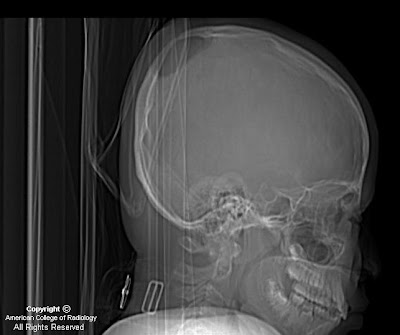


Findings
Coronal plane through frontal horns. Echogenic structures are seen on both sides, just posterior to the frontal horns. An arrowhead points to the echogenic material on the left which may either be in the subependymal area or within the ventricle. Orthogonal parasagittal or transcranial axial views may help differentiate between these possibilities. An arrow points to echogenic material, probably a clot in the temporal tip.
Coronal plane through lateral ventricles. A more posteriorly angulated view than Fig 1 shows the right and left lateral ventricles filled with heterogeneous material. This material consists both of homogeneously echogenic choroid and echopenic, and therefore subacute, clot. Acute clot is homogeneously echogenic similar to normal choroid plexus. Choroid plexus, however, is not seen anteriorly in the frontal horns, ie, anterior to the foramen of Munro.
Parasagittal plane through right lateral ventricle. The orthogonal view helps prove the clot is within a dilated lateral ventricle consistent with a Grade III hemorrhage. An arrowhead points to homogenous echogenic choroids inferior to the clot and not seen extending anterior to the foramen of Munro area, which can be estimated at about midthalamus. In addition, color Doppler can show vascular flow in normal choroid plexus but not in clot.
Diagnosis: Grade III IVH
Premature neonates, particularly those less than 1500 grams or less than 32 weeks gestational age, are at risk for subependymal and intraventricular hemorrhage. Essentially all these hemorrhages develop from bleeding from single-cell thick vessels in the subependymal area of the brain found between the head of the caudate nucleus and thalamus.
A number of years ago, Papille et al created a grading system for hemorrhages that has its proponents and detractors. It however remains an adequate method of communicating areas involved by intracranial subependymal hemorrhage.
Grade I hemorrhage consists of hemorrhage within the subependymal area. Older or resolved Grade I hemorrhages may be imaged as cysts in the subependymal area. This is not the only reason for the development of subependymal cysts.
Grade II hemorrhages extend from the subependymal area into the lateral ventricle with little, if any, ventricular dilatation.
Grade III hemorrhage is intraventricular hemorrhage with dilatation of the involved lateral ventricle.
Grade IV hemorrhages were once thought of as extensions of Grade III hemorrhages into the surrounding brain parenchyma.
In the late 1980s Volpe, noting a difference in timing for the development of echogenic, cystic, or mixed echogenicity areas in the brain compared to the earlier presence by 1-2 days of clot in the ventricle suggested that the intraparenchymal portion of the Grade IV IVH was due to associated venous infarction.
Patients with Grade I and II hemorrhages usually do well clinically. The results for more severe Grade III and IV hemorrhages is less good.








